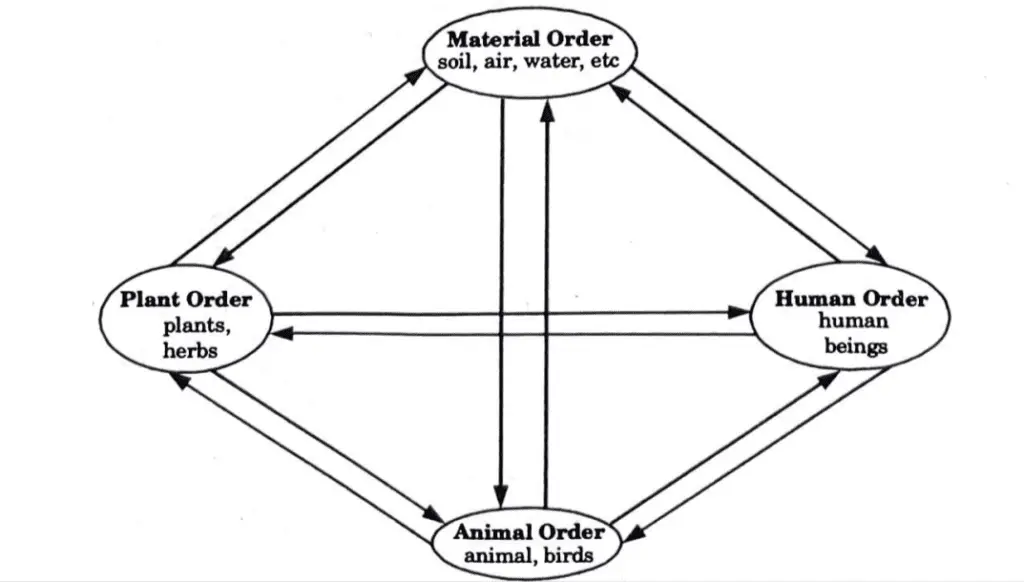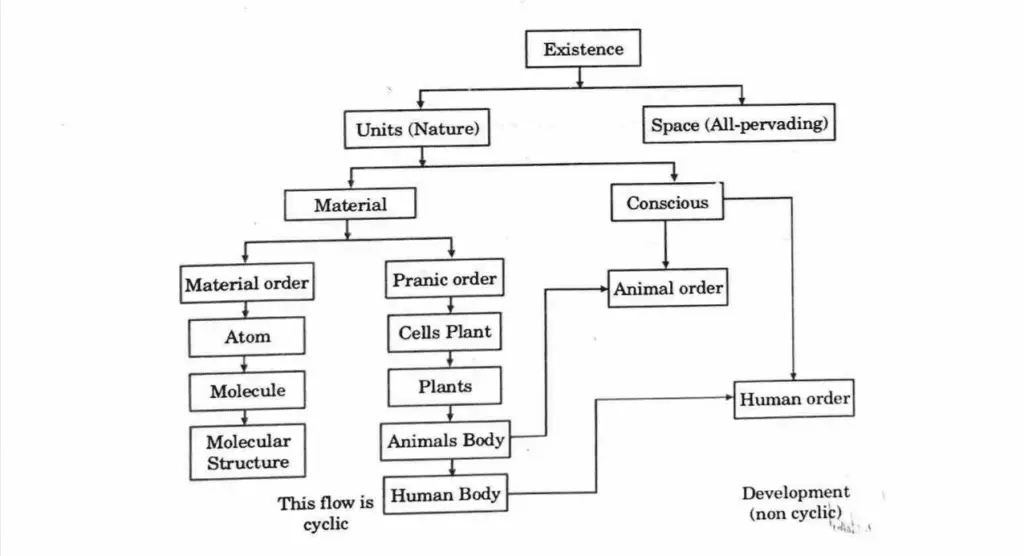We’re here to look at the most important questions and notes about human values that might come up in your next examinations, including Btech, MCA, and others. Here we are discussing for UNIT-4 UNDERSTANDING HARMONY IN THE NATURE & EXISTENCE
Guys 🤔.. You desire additional relevant information on the same. Don't forget to read this as well. Important Questions For Universal Human Values : *Unit-01 *Unit-02 *Unit-03 *Unit-04 *Unit-05 *Short-Q/Ans *Question-Paper with solution 21-22
Q1. What do you mean by mutual fulfillment in nature? Explain with examples.
Ans. 1. Nature is the collective name for all material objects, whether they be living or nonliving, that are in a solid, liquid, or gaseous condition. In other words, nature can be defined as the sum of all the mutually interacting entities, large or little, sentient or insentient.
2. Since there are an endless number of these units, we can plainly see that there is a dynamic balance and self-regulation among them all.
3. We may group all of these units together into four separate orders to make things easier to understand.
There are four orders of nature:
- i. Material order
- ii. Pranic order
- iii. Animal odder
- iv. Human order
Interconnectedness and mutual fulfillment in nature:
1. Each unit of the four orders of nature must be related to and enrich each other in order for there to be mutual fulfilment.
2. In the natural world, every component is interconnected and serves a purpose. Every other human being is related to us. We have feelings and emotions for everyone as a result. The human being is connected to every material object in existence and becomes aware of this as soon as he begins to explore it.
3. The four orders can be distinguished based on their traits, interactions with other units in related orders, activities, inheritance patterns, etc.
Example :
Material Order Plant/Bio-Order and Animal Order:
The material order serves as the foundation for all animal, bird, and fish movement. Both plants and animals require water, oxygen, and other gases. At the same time, the animal order enriches the soil with its excreta, and these excreta provide nutrients to the plants. Animals, birds, and fish eat from the plant/bio order. The animal order aids in the pollination of the pranic order’s flowers.
Q2. Explain recyclability and self-regulation in nature.
Ans. Recyclability:
1. In nature, we can see a number of cyclical processes. The cycle of water, for example, evaporating, condensing, and precipitating back to water produces weather phenomena. The earth’s cycles keep these materials self-regulating. Plant and animal breeds are similarly self-regulated in their environments.
2. In a forest, tree growth occurs in a way that preserves the quantity of soil, plants, and animals. It never happens that there isn’t enough soil for the trees as the population of trees increases. In nature, the proper conditions for both plant and animal growth self-regulate, maintaining the proportions of the population as it would in the wild. Self-regulation is the name given to this occurrence.
3. The quantity of men and females produced through reproduction in a single breed of animal ensures the survival of the species on its own. This also occurs in humans, however due to inhumane actions, there are disproportionately more males and women. These two traits—cyclicality and self-control—offer us some hints about the balance that exists in nature.
Self-regulation :
1. We are aware of a number of natural cycles, including the oxygen cycle, nitrogen cycle, water cycle, and carbon cycle. Animals need oxygen for breathing, which plants produce. They maintain the delicate harmony among the diverse elements of nature. They make that the material balance between the various components is maintained.
2. In a forest, tree growth occurs in a way that preserves the quantity of soil, plants, and animals. It never happens that there isn’t enough soil for the trees as the population of trees increases. In nature, the proper conditions for both plant and animal growth self-regulate, maintaining the proportions of the population as it would in the wild. Self-regulation is the name given to this occurrence.
3. Additionally, animals and plants depend on one another to maintain their populations. The requirements of each are met, and each gives the other what it requires to survive. So it makes sense that if we remove even one person from any of the orders, the equilibrium will be upset. This is an illustration of how nature may regulate itself while still maintaining interspecies harmony.
Q3. Briefly explain the natural characteristics of the four orders in nature.
Same Question Asked in Your Exams
- Explain the four orders existing in nature. How are they interlinked to one another?
- Briefly explain the natural characteristics of the four orders in nature.
- What are the four orders in nature? Describe their activities and natural characteristics.
- Describe various orders of harmony in nature. How do they support the universal system as a whole? Explain briefly.
- What are the natural characteristics of the material and pranic orders? Explain.
Ans.
1. The four kingdoms of matter, plant, animal, and human all share a few fundamental principles. These can also be referred to as their inherent qualities or svabhava.
2. There is mutual fulfillment among four orders, these orders are:
i. Material Order : The majority of the individuals in this order are not things. Additionally, several types of energies like gravitational energy, sound, light, heat, and magnetism are included in this order. Composition/decomposition is this order’s fundamental property. They can be combined to create larger objects, and larger objects can be divided into smaller ones. They cannot be made or taken away. Take the release of atomic energy during nuclear fusion and fission, for instance.
ii. Plant/Bio Order: From single cell organisms like fungi and algae to water plants, herbs, shrubs, and trees, they range in complexity. They have the capacity to develop, reproduce, take in food from the environment, and digest it. They also give the animal and human orders sustenance. As a result, nurturing is a natural attribute of this order. However, consuming too much food or uncontrolled amounts of plant products might hurt or “worsen” our bodies.
iii. Animal Order: This order’s members are living things. They share many characteristics with the plant order. They are able to move faster than plants. This order’s natural characteristic is that they recognise or are aware of the fact that they exist the quality of Self(I), and thus they have an intellectual faculty. This awareness also brings out the excess, which is cruelty, because they know they can meet their needs through violence and cruelty against members of other orders or within their own order.
iv. Human Order: They are the most developed of the four orders. They are living beings with natural characteristics that are similar to those of the plant and animal orders. They are self-sufficient and self-conscious. They have qualities such as perseverance, bravery, and generosity. These skills are unique to them. However, human nature has a tendency to deviate from its basic characteristics. This has resulted in numerous conflicts and contradictions in their fundamental nature.



Q4. Suggest ways to enhance the fulfillment of human order with the other three orders. Mention any two programs you can undertake in light of the above.
Same Question Asked in Your Exams
- What are the four orders in nature? ·uow are they interdependent and mutually fulfilling for each other? Explain.
- “Other than human order, the three orders are mutually fulfilling to each other”. Explain with examples. Why does the human order fail to be mutually fulfilling to itself and to other orders?
- Closely examine four orders ·in nature and their participation, explain present state of participation of human order.
Ans. In nature, all of the units are interconnected and mutually beneficial. Every human being is related to every other human being. We have feelings and emotions for everyone on this basis. The human being is connected to all material units in existence and becomes aware of this as he begins to explore it. We can see this interconnectedness and mutual fulfillment :
1. Material Order and Plant/Bio-Order: The material order provides nutrients to the plant/bio order in the form of soil, minerals, and so on, while the plant/bio order decays and forms additional nutrients, enriching the soil. The plant/bio order also decays to substances such as oil and coal, which are stored deep within the earth to protect against heat from the earth’s molten core as well as heat from the sun (today, this is the material we are removing and using as fuel). Plants aid in the movement of nutrients through the soil’s various layers. The roots of plants hold the soil together and keep it from eroding. Plants generate oxygen and carbon dioxide, which aid in the movement of the material order. We can see mutual interdependence and coexistence here.
2. Material Order, Plant/Bio- Order and Animal Order: The material order serves as the foundation for all animal, bird, and fish movement. Both plants and animals require water, oxygen, and other gases. At the same time, the animal order enriches the soil with its excreta, and these excreta provide nutrients to the plants. Animals, birds, and fish eat from the plant/bio order. The animal Order aids in the pollination of the Pranic Order’s flowers.
3. Material Order, Plant/Bio- Order, Animal Order and Human Order: We humans have a natural acceptance of being mutually fulfilling to these three orders. However, we are unable to ensure this mutual fulfillment. We rely on the material order for soil, minerals, and metals, but we only end up polluting the soil and depleting fossil fuels; we rely on plants for food and to hold the larger ecosystem together, but we have destroyed forests and wiped out multiple plant and herb species; Counting the number of animals in the world. Except for the human order, we can see that all orders of nature are interconnected and mutually fulfilling. We must work on this.



Q5. Draw a chart showing in detail, the different categories of UNITs of nature in co-existence in space. What is your role in existence?
Same Question Asked in Your Exams
- Explain the following three realities Units (Material, Conscious), Space, and Co-existence.
Ans. 1. Units: Units have a finite number of possibilities. They are all limited in size, bounded on six sides, and range in size from a small blade of human hair to the largest planets we know of. So everything we’ve studied thus far, including humans, animals, lumps of matter, and various atoms and molecules, is a unit. We can identify them as such, and they are countable.
2. Space: Space is defined as an infinite entity. It has no size and thus cannot be bound, unlike a unit. However, space maintains a certain regularity and follows certain laws. The environment is reflecting. This means that it can be explained using its relationship to other objects. For example, we might say there is space between you and the book you’re reading. Space is also transparent, which means that there are no obstacles in space.
3. Co-existence : The relationship in this type of coexistence is founded on mutual respect for diversity. In this relationship, the groups accept each other’s differences and have equal access to resources and opportunities. The environment is one of peace, social cohesion, justice and equality, mutual tolerance, respect for different points of view, and nonviolent living.
The diagram below depicts the relationship between the various orders of nature. We can see that nature’s four orders coexist in harmony. This exists in nature and does not need to be created. Nature’s units are small in size and self-organized. Space is limitless, and there is always reflecting energy available in the all-encompassing space. Only the human and animal orders have received self-consciousness. The material order is constantly changing structurally. The conscious order does not change structurally. Because conscious units can learn, they can know, assume, recognise, and fulfill .



Q6. Describe briefly the criteria for evaluation of Holistic technology. Support your answer with an example.
Same Question Asked in Your Exams
- What is holistic technology? Take any two such examples from Indian tradition and elaborate on them.
- Analyze the importance of holistic technology in the current scenario with different examples
Ans. 1. Right understanding aids in the development of a holistic approach vision. By holistic approach, we mean that the processes and technologies we use must be environmentally friendly. A holistic model is inherently supportive of the overall human goal. Modern technology is the offspring of the human brain. Every invention is the result of a growing need. In order to facilitate the development of holistic technologies it is indispensible to create specific criteria for holistic evaluation of technologies. We have these broad criteria to guide the development of such technologies and systems :
- i. Caring to appropriate needs and life style.
- ii. People-friendly.
- iii. Eco-friendly.
2. Because of the widespread use of natural resources, modern technologies are causing environmental issues. We are using fossil fuels as well as other renewable resources. Natural resources are in high demand around the world, and they are depleting at an alarming rate. There is now a growing global demand for the development of alternative renewable technologies and modes of production.
3. Certainly, this is only possible with a proper understanding and assessment of human needs. We must focus on renewable energy technologies. For human welfare, we must conduct research into environmentally friendly technology.
4. When we use technology, we must remember to consider people’s needs. We must make every effort to create people-friendly technology. Because the purpose of technology is to help people, and this must be kept in mind as we develop a system. Science and technology are no longer being used solely for human welfare, and this is occurring in society as a result of a lack of proper understanding and evaluation of human needs.
5. We are making technology anti-human rather than human-friendly. For proper technology utilization, we must first determine our basic needs through proper understanding.
Full Info About Holistic Approach & Technology is attached to this Article



Important Question Unit wise…🤔
Such a Great Idea😍
Now Exam Made Easy…😊
Important Questions For Universal Human Values -B.Tech AKTU
| Important Question | Question Links |
|---|---|
| human values notes – Unit-1 | UNIT-1 |
| human values notes – Unit-2 | UNIT-2 |
| human values notes – Unit-3 | UNIT-3 |
| human values notes – Unit-4 | UNIT-4 |
| human values notes – Unit-5 | Unit-5 |
| human Values Short Questions | short-questions |
| human values Question-paper | 2021-22 |
AKTU Important Links
| Link Name | Links |
|---|---|
| Btech AKTU Circulars | Links |
| Btech AKTU Syllabus | Links |
| Btech AKTU Student Dashboard | Student Dashboard |
| AKTU RESULT (One VIew) | Student Result |

2 thoughts on “(AKTU) Universal Human Values Important Unit-4”